Azurite
| Azurite | |
|---|---|
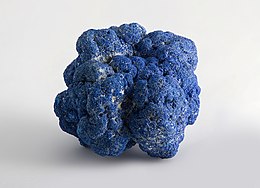 Azurite from Burra Mine, South Australia | |
| General | |
| Category | Carbonate mineral |
| Formula (repeating unit) | Cu3(CO3)2(OH)2 |
| Strunz classification | 5.BA.05 |
| Crystal system | Monoclinic |
| Crystal class | Prismatic (2/m) (same H-M symbol) |
| Space group | P21/c |
| Unit cell | a = 5.01 Å, b = 5.85 Å c = 10.35 Å; β = 92.43°; Z = 2 |
| Identification | |
| Formula mass | 344.67 g/mol |
| Color | Azure-blue, dark to pale blue; pale blue in transmitted light |
| Crystal habit | Massive, prismatic, stalactitic, tabular |
| Twinning | Rare, twin planes {101}, {102} or {001} |
| Cleavage | Perfect on {011}, fair on {100}, poor on {110} |
| Fracture | Conchoidal |
| Tenacity | brittle |
| Mohs scale hardness | 3.5 to 4 |
| Luster | Vitreous |
| Streak | Light blue |
| Diaphaneity | Transparent to translucent |
| Specific gravity | 3.773 (measured), 3.78 (calculated) |
| Optical properties | Biaxial (+) |
| Refractive index | nα = 1.730 nβ = 1.758 nγ = 1.838 |
| Birefringence | δ = 0.108 |
| Pleochroism | Visible shades of blue |
| 2V angle | Measured: 68°, calculated: 64° |
| Dispersion | relatively weak |
| References | [1][2][3] |
Azurite is a soft, deep-blue copper mineral produced by weathering of copper ore deposits. During the early 19th century, it was also known as chessylite, after the type locality at Chessy-les-Mines near Lyon, France.[2] The mineral, a basic carbonate with the chemical formula Cu3(CO3)2(OH)2, has been known since ancient times, and was mentioned in Pliny the Elder's Natural History under the Greek name kuanos (κυανός: "deep blue," root of English cyan) and the Latin name caeruleum.[4] Since antiquity, azurite's exceptionally deep and clear blue has been associated with low-humidity desert and winter skies. The modern English name of the mineral reflects this association, since both azurite and azure are derived via Arabic from the Persian lazhward (لاژورد), an area known for its deposits of another deep-blue stone, lapis lazuli ("stone of azure").
Mineralogy[]

Azurite has the formula Cu3(CO3)2(OH)2, with the copper(II) cations linked to two different anions, carbonate and hydroxide. It is one of two relatively common basic copper(II) carbonate minerals, the other being bright green malachite. Aurichalcite is a rare basic carbonate of copper and zinc.[5] Simple copper carbonate (CuCO3) is not known to exist in nature, due to the high affinity of the Cu2+
ion for the hydroxide anion HO−
.[6]
Azurite crystallizes in the monoclinic system.[7] Large crystals are dark blue, often prismatic.[2][3][5] Azurite specimens can be massive to nodular or can occur as drusy crystals lining a cavity.[8]
Azurite is soft, with a Mohs hardness of only 3.5 to 4. The specific gravity of azurite is 3.77. Azurite is destroyed by heat, losing carbon dioxide and water to form black, copper(II) oxide powder. Characteristic of a carbonate, specimens effervesce upon treatment with hydrochloric acid. The combination of deep blue color and effervescence when moistened with hydrochloric acid are identifying characteristics of the mineral.[5][8]
Color[]
The optical properties (color, intensity) of minerals such as azurite and malachite are characteristic of copper(II). Many coordination complexes of copper(II) exhibit similar colors. According to crystal field theory, the color results from low energy d-d transitions associated with the d9 metal center.[9][10]
Weathering[]
Azurite is unstable in open air compared to malachite, and often is pseudomorphically replaced by malachite. This weathering process involves the replacement of some of the carbon dioxide (CO2) units with water (H2O), changing the carbonate:hydroxide ratio of azurite from 1:1 to the 1:2 ratio of malachite:[5]
- 2 Cu3(CO3)2(OH)2 + H2O → 3 Cu2(CO3)(OH)2 + CO2
From the above equation, the conversion of azurite into malachite is attributable to the low partial pressure of carbon dioxide in air.
Azurite is quite stable under ordinary storage conditions, so that specimens retain their deep blue color for long periods of time.[11]
Occurrences[]
Azurite is found in the same geologic settings as its sister mineral, malachite, though it is usually less abundant. Both minerals occur widely as supergene copper minerals, formed in the oxidized zone of copper ore deposits. Here they are associated with cuprite, native copper, and various iron oxide minerals.[5]
Fine specimens can be found at many locations. Among the best specimens are found at Bisbee, Arizona, and nearby locations, and have included clusters of crystals several inches long and spherical aggregates and rosettes up to 2 inches (51 mm) in diameter. Similar rosettes are found at Chessy, Rhône, France. The best crystals, up to 10 inches (250 mm) in length, are found at Tsumeb, Namibia. Other notable occurrences are in Utah; Mexico; the Ural and Altai Mountains; Sardinia; Laurion, Greece; Wallaroo, South Australia; and Broken Hill.[8]
Uses[]
Pigments[]
Azurite is unstable in air. However it was used as a blue pigment in antiquity.[12] Azurite is naturally occurring in Sinai and the Eastern Desert of Egypt. It was reported by F. C. J. Spurrell (1895) in the following examples; a shell used as a pallet in a Fourth Dynasty (2613 to 2494 BCE) context in Meidum, a cloth over the face of a Fifth Dynasty (2494 to 2345 BCE) mummy also at Meidum and a number of Eighteenth Dynasty (1543–1292 BCE) wall paintings.[13] Depending on the degree of fineness to which it was ground, and its basic content of copper carbonate, it gave a wide range of blues. It has been known as mountain blue or Armenian stone, in addition it was formerly known as Azurro Della Magna (from Italian). When mixed with oil it turns slightly green. When mixed with egg yolk it turns green-grey. It is also known by the names blue bice and blue verditer, though verditer usually refers to a pigment made by chemical process. Older examples of azurite pigment may show a more greenish tint due to weathering into malachite. Much azurite was mislabeled lapis lazuli, a term applied to many blue pigments. As chemical analysis of paintings from the Middle Ages improves, azurite is being recognized as a major source of the blues used by medieval painters. Lapis lazuli (the pigment ultramarine) was chiefly supplied from Afghanistan during the Middle Ages, whereas azurite was a common mineral in Europe at the time. Sizable deposits were found near Lyons, France. It was mined since the 12th century in Saxony, in the silver mines located there.[14]
Heating can be used to distinguish azurite from purified natural ultramarine blue, a more expensive but more stable blue pigment, as described by Cennino D'Andrea Cennini. Ultramarine withstands heat, whereas azurite converts to black copper oxide.[15] However, gentle heating of azurite produces a deep blue pigment used in Japanese painting techniques.[16]
Azurite pigment can be synthesized by precipitating copper(II) hydroxide from a solution of copper(II) chloride with lime (calcium hydroxide) and treating the precipitate with a concentrated solution of potassium carbonate and lime. This pigment is likely to contain traces of basic copper(II) chlorides.[17]

Ground azurite for use as a pigment

The background of Lady with a Squirrel by Hans Holbein the Younger was painted with Azurite

The greenish tint of the Madonna's mantle in Raphael's Madonna and Child Enthroned with Saints is due to azurite weathering to malachite
Jewelry[]
Azurite is used occasionally as beads and as jewelry, and also as an ornamental stone.[18] However, its softness and tendency to lose its deep blue color as it weathers limit such uses.[19] Heating destroys azurite easily, so all mounting of azurite specimens must be done at room temperature.
Collecting[]
The intense color of azurite makes it a popular collector's stone. The notion that specimens must be carefully protected from bright light, heat, and open air to retain their intensity of color over time may be an urban legend. Paul E. Desautels, former curator of gems and minerals at the Smithsonian Institution, has written that azurite is stable under ordinary storage conditions.[11]
Prospecting[]
While not a major ore of copper itself, the presence of azurite is a good surface indicator of the presence of weathered copper sulfide ores. It is usually found in association with the chemically similar malachite, producing a striking color combination of deep blue and bright green that is strongly indicative of the presence of copper ores.[5]
History[]
The use of azurite and malachite as copper ore indicators led indirectly to the name of the element nickel in the English language. Nickeline, a principal ore of nickel that is also known as niccolite, weathers at the surface into a green mineral (annabergite) that resembles malachite. This resemblance resulted in occasional attempts to smelt nickeline in the belief that it was copper ore, but such attempts always ended in failure due to high smelting temperatures needed to reduce nickel. In Germany this deceptive mineral came to be known as kupfernickel, literally "copper demon." The Swedish alchemist Baron Axel Fredrik Cronstedt (who had been trained by Georg Brandt, the discoverer of the nickel-like metal cobalt) realized that there was probably a new metal hiding within the kupfernickel ore, and in 1751 he succeeded in smelting kupfernickel to produce a previously unknown (except in certain meteorites) silvery white, iron-like metal. Logically, Cronstedt named his new metal after the nickel part of kupfernickel.
Gallery of azurite mineral specimens[]

Azurite crystals from China

Azurite from Arizona, collected by Dr John Hunter in the 18th century, Hunterian Museum, Glasgow
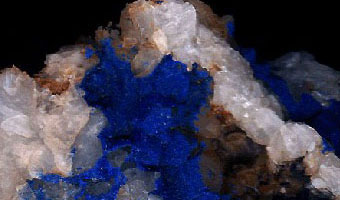
Fresh, unweathered azurite crystals showing the deep blue of unaltered azurite. From Špania Dolina, Slovakia
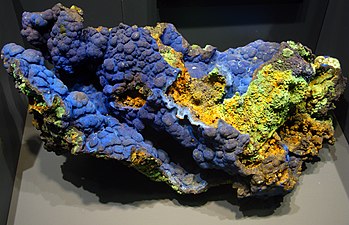
Azurite with Malachite, Copper Queen mine, Bisbee, Arizona

Azurite from Touissit, Morocco

Azurite, Morenci, Arizona
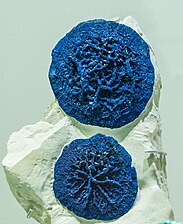
Azurite in siltstone, Malbunka mine, Northern Territory, Australia
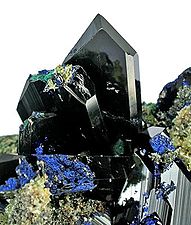
Azurite from Tsumeb, Namibia
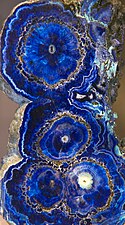
Azurite, cross-section through merged stalactites, Bisbee, Arizona
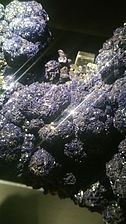
Azurite crystal, from the minerals' collection at the Natural History Museum, London.

Spheroidal azurite specimens from Utah
See also[]
References[]
- ^ Handbook of Mineralogy
- ^ Jump up to: a b c Mindat.org
- ^ Jump up to: a b Webmineral.com Webmineral Data
- ^ The Ancient Library: Smith, Dictionary of Greek and Roman Antiquities, p.321, right col., under BLUE Archived December 20, 2005, at the Wayback Machine
- ^ Jump up to: a b c d e f Klein, Cornelis; Hurlbut, Cornelius S., Jr. (1993). Manual of mineralogy : (after James D. Dana) (21st ed.). New York: Wiley. pp. 417–418. ISBN 047157452X.
- ^ Ahmad, Zaki (2006). Principles of Corrosion Engineering and Corrosion Control. Oxford: Butterworth-Heinemann. pp. 120–270. ISBN 9780750659246.
- ^ Zigan, F.; Schuster, H.D. (1972). "Verfeinerung der Struktur von Azurit, Cu3(OH)2(CO3)2, durch Neutronenbeugung". Zeitschrift für Kristallographie, Kristallgeometrie, Kristallphysik, Kristallchemie. 135 (5–6): 416–436. Bibcode:1972ZK....135..416Z. doi:10.1524/zkri.1972.135.5-6.416.
- ^ Jump up to: a b c Sinkankas, John (1964). Mineralogy for amateurs. Princeton, N.J.: Van Nostrand. pp. 379–381. ISBN 0442276249.
- ^ Nassau, K. (1978). "The origins of color in minerals". American Mineralogist. 63 (3–4): 219–229.
- ^ Klein & Hurlbut 1993, pp. 260–263.
- ^ Jump up to: a b Desautels, Paul E. (January 1991). "Some Thoughts about Azurite". Rocks & Minerals. 66 (1): 14–23. doi:10.1080/00357529.1991.11761595.
- ^ Gettens, R.J. and Fitzhugh, E.W., Azurite and Blue Verditer, in Artists’ Pigments. A Handbook of Their History and Characteristics, Vol. 2: A. Roy (Ed.) Oxford University Press 1993, p. 23–24
- ^ Nicholson, Paul; Shaw, Ian (2000). Ancient Egyptian Materials and Technology. Cambridge University Press. ISBN 978-0521452571.
- ^ Andersen, Frank J. Riches of the Earth. W.H. Smith Publishers, New York, 1981, ISBN 0-8317-7739-7
- ^ Muller, Norman E. (January 1978). "Three Methods of Modelling the Virgin's Mantle in Early Itallan Painting". Journal of the American Institute for Conservation. 17 (2): 10–18. doi:10.1179/019713678806029166.
- ^ Nishio, Yoshiyuki (January 1987). "Pigments Used in Japanese Paintings". The Paper Conservator. 11 (1): 39–45. doi:10.1080/03094227.1987.9638544.
- ^ Orna, Mary Virginia; Low, Manfred J. D.; Baer, Norbert S. (May 1980). "Synthetic Blue Pigments: Ninth to Sixteenth Centuries. I. Literature". Studies in Conservation. 25 (2): 53. doi:10.2307/1505860. JSTOR 1505860.
- ^ Mueller, Wolfgang (31 January 2012). "Arizona Gemstones". Rocks & Minerals. 87 (1): 64–70. doi:10.1080/00357529.2012.636241. ISSN 0035-7529. S2CID 219714562.
- ^ Schumann, Walter (2009). Gemstones of the world (4th, newly rev. & expanded ed.). New York: Sterling. ISBN 9781402768293. Retrieved 18 September 2021.
External links[]
| Wikimedia Commons has media related to Azurite. |
- Spencer, Leonard James (1911). . Encyclopædia Britannica. 3 (11th ed.). p. 86.
- Azurite, Colourlex
- Carbonate minerals
- Copper ores
- Gemstones
- Inorganic pigments
- Monoclinic minerals
- Minerals in space group 14













